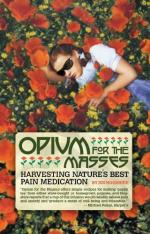|
This section contains 354 words (approx. 2 pages at 300 words per page) |
The unripe seed capsules of the poppy plant (Papaver somniferum) produce a milky juice called opium. The opium poppy has white or blue-purple flowers and is widely grown in Asia, India, and Turkey, which supply much of the world's opium. Opium contains substances known as opioids, many of which are used as medicines to treat pain. The major opioid analgesics (painkillers) are morphine and codeine.
 In this drawing from the Illustrated London News, July 1857, workers in Hong Kong transfer bales of opium from one ship to another for export to the West.
In this drawing from the Illustrated London News, July 1857, workers in Hong Kong transfer bales of opium from one ship to another for export to the West.
People have known about and used opium since ancient times. Initially it was used for the treatment of diarrhea and then for the relief of pain. Today, the major medicinal use of opium is to treat extreme diarrhea. Physicians may prescribe paregoric, a preparation made from a concentrated extract of opium.
The opium plant was introduced into India by Arab traders of the thirteenth century. It later spread to China, where the Chinese invented a method of smoking opium in pipes. In the eighteenth century, the British bought tea from China and in return shipped opium to the Chinese. By 1900 about 25 percent of the Chinese smoked opium, although it was banned by the emperor. In the early twentieth century, international conferences placed limits on the traffic in opium and opium products.
People who abuse opium either smoke it or eat it. Opium eating is widely practiced in India, Turkey, Afghanistan, and Southeast Asia. Opium is used as a household remedy for pain and other ailments, much as it has been for hundreds of years. Approximately 50 percent of opium eaters in India, for example, use it for medicinal purposes. Small numbers of immigrants to the United States have brought these customs with them, but opium abuse is rare in this country.
See Also
|
This section contains 354 words (approx. 2 pages at 300 words per page) |


